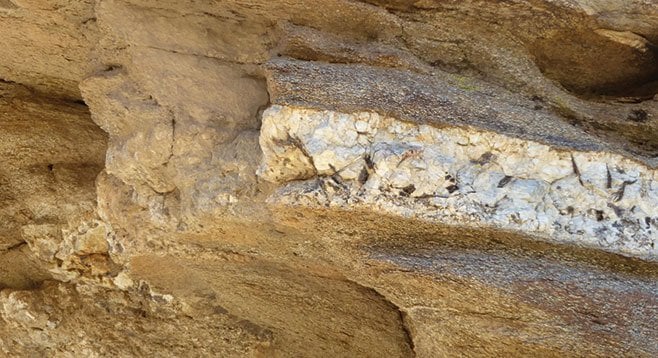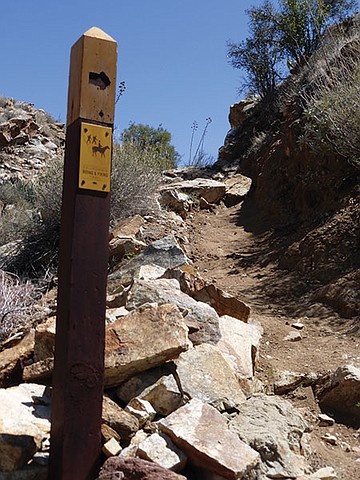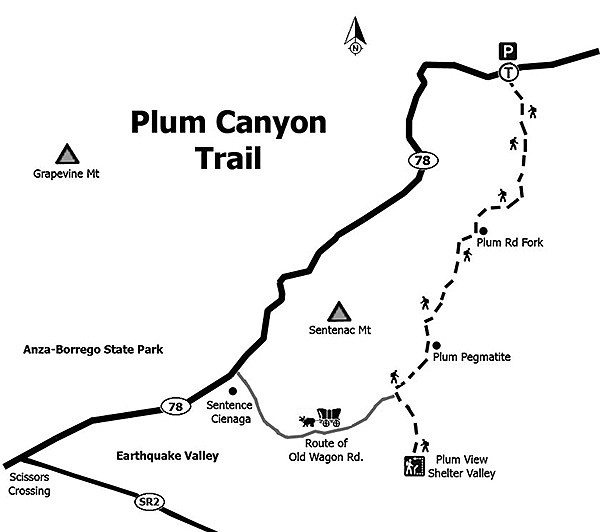 Facebook
Facebook
 X
X
 Instagram
Instagram
 TikTok
TikTok
 Youtube
Youtube

There are no plum trees in Plum Canyon. It is possibly a misnomer caused by incorrectly identifying a desert apricot tree as a desert plum. In fact, there are no desert plums in the Anza-Borrego area. A plant that is similar to a desert apricot that is also found in this region is the desert almond, but not in Plum Canyon. Another possibility for the name of the canyon is attributed to cattleman John McCain who, with his brother, constructed a wagon road through to Plum Canyon to travel between the Shelter or Earthquake Valley and Yaqui Well sometime before 1913, many years before SR-78 was constructed. McCain grew plums on his ranch in Julian in the 1890s, so perhaps there is a connection there. An earlier name for this canyon was Wagon Wash, named for the wagon road that the McCains constructed.

Today it is difficult to fathom that a wagon road cut through from Shelter/Earthquake Valley to Plum Canyon, as rockslides have made it impassable. However, as a hiking route it is well worth exploring. The California Riding and Hiking Trail (CRHT) follows upper Plum Canyon and continues on to the Pinyon Mountain Road in Shelter Valley and then on into Blair Valley. The canyon has a wide diversity of plants because of its location in the Desert Transition Zone with 175 taxa identified. Beginning the hike at the entrance to Plum Canyon makes for a longer but more interesting hike, as it is a good way to experience the transition from lower elevation desert vegetation to the lower part of the Desert Transition Zone. Plum Canyon is a favorite for the California Native Plant Society.
At about mile 1.4 from the entrance to Plum Canyon, the road forks. Go right. The dirt road ends at about mile 1.8. The shorter hike begins here. Plants to note in the lower elevation area includes agave, lavender, creosote, chuparosa, brittlebush, ocotillo, and a variety of cacti including hedgehog, teddy bear, and staghorn cholla. While hiking up the alluvial fan, note the many smoke trees that are found in the wash. Soon after leaving the upper parking area is the first encounter with apricot trees, California juniper, Mojave yucca, desert willow, and barrel cactus. This mixed transition area also has ephedra and acacia. Note the mistletoe found on the acacia.

At 2.11 miles, the trail goes to the right and over a dry waterfall. A sign indicates that it is part of the CRHT and that horses are allowed on the trail. At 2.4 miles, look for a large and interesting pegmatite dike with quartz, black tourmaline, and wind caves on the right. About a quarter-mile further is a side canyon where the old Plum Canyon Road came into the wash from Shelter/Earthquake Valley. If exploring this side canyon, look for traces of the old wagon road. Continuing up the main wash, at 2.86 there is another CRHT sign before a steep climb that leads to the overview of Shelter/Earthquake Valley at elevation 2720 feet. The view of Granite Mountain is to the west. The start of the old wagon road is not visible from this point, as the view is blocked. Retrace steps back to your vehicle.


There are no plum trees in Plum Canyon. It is possibly a misnomer caused by incorrectly identifying a desert apricot tree as a desert plum. In fact, there are no desert plums in the Anza-Borrego area. A plant that is similar to a desert apricot that is also found in this region is the desert almond, but not in Plum Canyon. Another possibility for the name of the canyon is attributed to cattleman John McCain who, with his brother, constructed a wagon road through to Plum Canyon to travel between the Shelter or Earthquake Valley and Yaqui Well sometime before 1913, many years before SR-78 was constructed. McCain grew plums on his ranch in Julian in the 1890s, so perhaps there is a connection there. An earlier name for this canyon was Wagon Wash, named for the wagon road that the McCains constructed.

Today it is difficult to fathom that a wagon road cut through from Shelter/Earthquake Valley to Plum Canyon, as rockslides have made it impassable. However, as a hiking route it is well worth exploring. The California Riding and Hiking Trail (CRHT) follows upper Plum Canyon and continues on to the Pinyon Mountain Road in Shelter Valley and then on into Blair Valley. The canyon has a wide diversity of plants because of its location in the Desert Transition Zone with 175 taxa identified. Beginning the hike at the entrance to Plum Canyon makes for a longer but more interesting hike, as it is a good way to experience the transition from lower elevation desert vegetation to the lower part of the Desert Transition Zone. Plum Canyon is a favorite for the California Native Plant Society.
At about mile 1.4 from the entrance to Plum Canyon, the road forks. Go right. The dirt road ends at about mile 1.8. The shorter hike begins here. Plants to note in the lower elevation area includes agave, lavender, creosote, chuparosa, brittlebush, ocotillo, and a variety of cacti including hedgehog, teddy bear, and staghorn cholla. While hiking up the alluvial fan, note the many smoke trees that are found in the wash. Soon after leaving the upper parking area is the first encounter with apricot trees, California juniper, Mojave yucca, desert willow, and barrel cactus. This mixed transition area also has ephedra and acacia. Note the mistletoe found on the acacia.

At 2.11 miles, the trail goes to the right and over a dry waterfall. A sign indicates that it is part of the CRHT and that horses are allowed on the trail. At 2.4 miles, look for a large and interesting pegmatite dike with quartz, black tourmaline, and wind caves on the right. About a quarter-mile further is a side canyon where the old Plum Canyon Road came into the wash from Shelter/Earthquake Valley. If exploring this side canyon, look for traces of the old wagon road. Continuing up the main wash, at 2.86 there is another CRHT sign before a steep climb that leads to the overview of Shelter/Earthquake Valley at elevation 2720 feet. The view of Granite Mountain is to the west. The start of the old wagon road is not visible from this point, as the view is blocked. Retrace steps back to your vehicle.